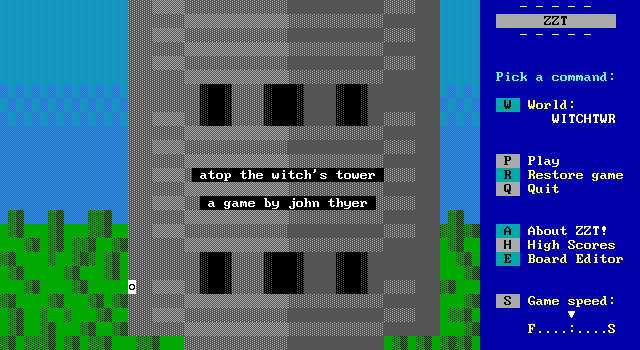
ZZT is dead. Long live ZZT.
After about 25 years of games and its slow death at the hands of deprecated operating systems, ZZT drew its last breath and died. It left behind a legacy of games by developers no longer dealing with the stresses of middle and high school, but now dealing with a new life in the workplace, teaching classes, developing web browsers, researching linguistics, or perhaps still creating yet more games for fun and/or profit. When the Museum started, it was expected that the new ZZT games would be a rare exception to a dead medium.
Benco's Ana, which I praise endlessly in these articles, was a surprise at the start of 2017. A former ZZTer going back and creating something brilliant, and bringing ZZT to modern times. It was fantastic, but it was somebody already intimately familiar with the engine taking a nostalgic journey to the past.
But 2017 brought us Atop The Witch's Tower, by John Thyer. Thyer, who already had made several games (available on his Itch.io page), had never played ZZT until it was dead and forgotten. Anna Anthropy's book on ZZT, aptly named ZZT, inspired a reader to check out this then 27-year old DOS game and create one more.
Built outside of the usual influences of the community, Thyer's game feels very un-ZZT. It focuses on story above all else, using simple mechanics to guide a player through it, and frankly it's another favorite of mine. The focus on telling a story and having the game's elements support it is the mark (to me) of what a modern ZZT game is all about. A ZZT world that doesn't want to be compared to Final Fantasy or Super Mario, but something that is confident in just being its own experience.
I first played the game live on stream back in 2017, and I'm terrified to link the video because it's so early into my creating content for the Museum that it's probably awful to listen to. But it's been two years now, and I think it's time to properly go through the game once more and really appreciate what an inexperienced and unfamiliar new face can contribute to ZZT's legacy.
Your name is MARY. You are a WITCH, and
today is a very important day for you.
Today, you're sacrificing your very first
PRINCESS!
Around these parts, every witch worth her
weight in bat guano has sacrificed at
-least- one princess. After all, the only
way to obtain DARK MAGIC POWER is to make
ritual sacrifices to the DARK EMPRESS.
And everyone knows princesses are the most
powerful sacrifice of all!
Everything is ready. PRINCESS LUCY is tied
up on the roof. You've already drawn the
MAGIC CIRCLE around her. You've even spent
a few hours in your MAGICAL EXTRA-
DIMENSIONAL SOUL PALACE relaxing and
psyching yourself up.
You feel ready to DO THIS THING. All
that's left is to check on the princess
and nab just a few more ingredients from
around the tower.
You are EXTREMELY NERVOUS.
• • • • • • • • •
There are all sorts of tiny things to notice if you're looking. The game immediately opens with an introductory scroll, which is in a object that hasn't been named. Though, after seeing how many objects had no names in ZZTV 3, I'm curious if I'm personally in the minority for making sure to name any object that will have its name displayed to the player.
But the lack of a name isn't what's important here, the story is what counts. It's straightforward and highlights all the important parts. Atop The Witch's Tower is a game about sacrificing a princess, namely princess Lucy, and the anxiety over performing the ritual for the very first time.

The starting board is this frightening looking maze, that may upon taking it in at once like this, lead to a sudden fear of this being a terrible game that starts with navigating an empty maze. This may have been a reasonable fear in the 90s and aughts, but when you're making your very first ZZT game and it's 2017, you are probably older than 15 and well aware of how not fun that would be.
The maze isn't here to be solved (you just walk straight up to the exit), it's meant to represent the confusing inner mind of Mary the witch. It's empty because it's a place of solitude and comfort, free of distraction.

Exiting her "magical extra-dimensional soul palace", Mary returns to her four-story tower, with each floor helpfully labeled.
Thyer makes a fun decision here to allow two stories to fit on a single ZZT board, but obscures the one Mary isn't currently on. The game is simple enough that both floors could be displayed without fear of running out of memory, but doing it this way makes each new floor a surprise. The fourth floor is Mary's personal chambers.

Mary's bedroom can be explored, but only to a small extent. You can examine her bed and dresser (where she'll decline taking a nap or changing into something else), but some of the other objects are unable to be interacted with.
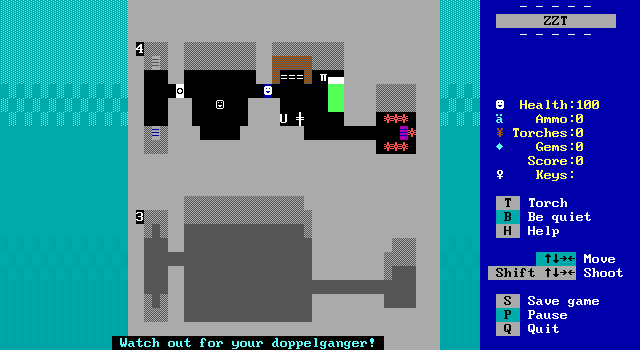
This feels so extremely early ZZT. Like something out of Ezanya, or honestly even one of the original worlds. Exiting the bedroom leads to a room whose sole purpose is for a doppelganger to wander around and shoot in Mary's direction.
It's got that weird nonsensical ZZT charm of somebody making something just because they can. The doppelganger can't be defeated or reasoned with, so Mary must flee, in this case I opted to go atop the witch's tower.
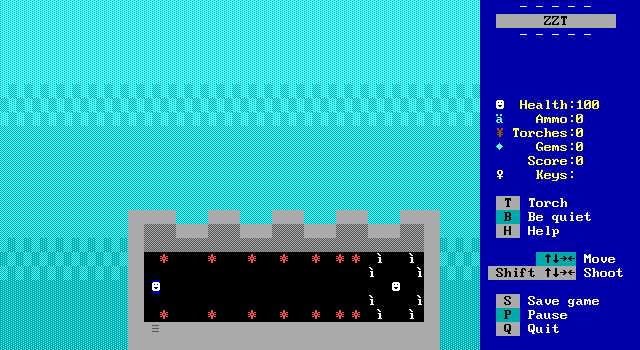
I love love love the composition on this board. It's so incredibly simple, but it conveys so much with so little. You can tell immediately that there's a ring of candles with Lucy in the center. The positioning of the tower even fits with the previous floors which means that the board is more background sky than anything else.
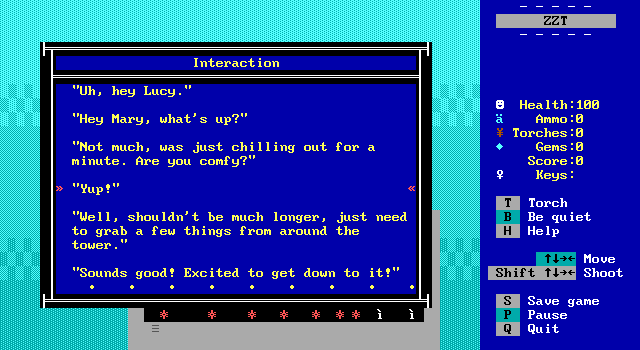
Thyer plays with the expectations here. Lucy isn't some unwilling victim, but somebody totally enthusiastic about her role. The two get along just fine, and chat before Mary returns to her quest to get the necessary components for the ritual.
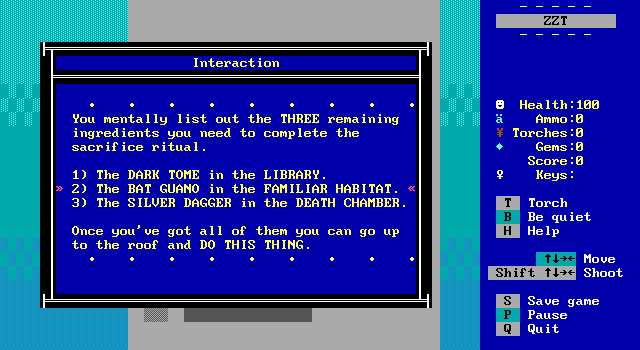
Heading down the tower instead, you learn of the items needed to begin the sacrifice. Everything is helpfully highlighted, though the game is short enough that it's pretty clear what can be obtained as you come across it.
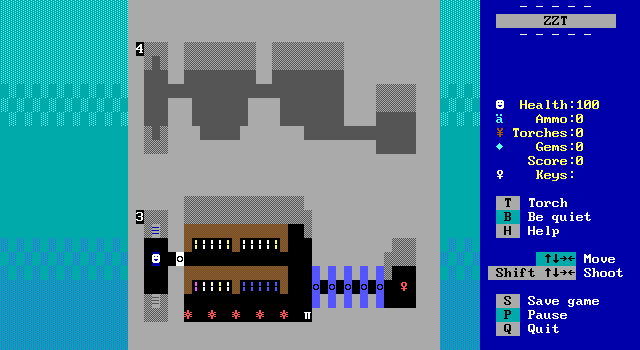
The third floor is a library, with what looks to be some sort of puzzle protecting a red key.
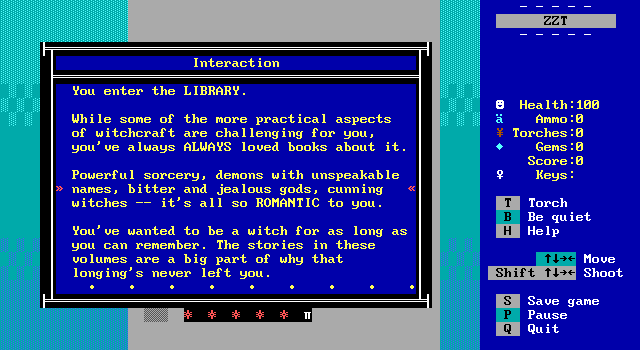
This game absolutely glamorizes being a witch.
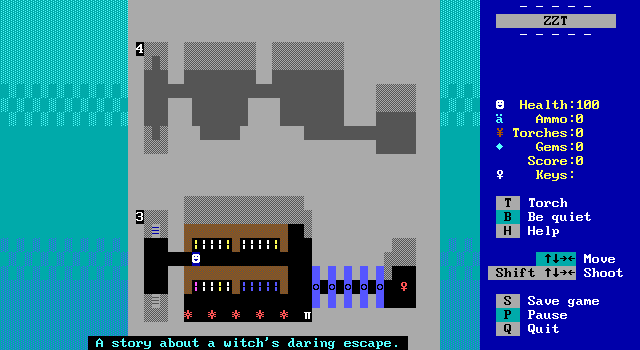
Thyer, lacking the endless influences of "this is what a bookshelf looks like in ZZT", takes both an unusual choice of representing the books themselves, with pipes rather than half blocks and making not every one of them something that can be examined, marking those that can by giving them a different color.
After seeing countless bookshelves over the years full of jokes which are rarely as clever as the author hopes, it's nice to see Thyer instead limiting himself to just a few descriptions. Instead of cheap puns, Thyer turns the idea of a ZZT bookshelf into an opportunity to show Mary's personality by describing the kind of books she enjoys. Books about witches obvs.
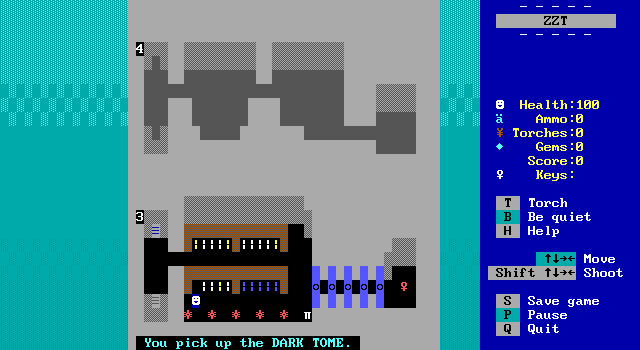
The blue books mention how Mary doesn't want to solve any math puzzles, implying their use in opening the blue doors to the side, and the last red book is the DARK TOME needed to perform the ritual.
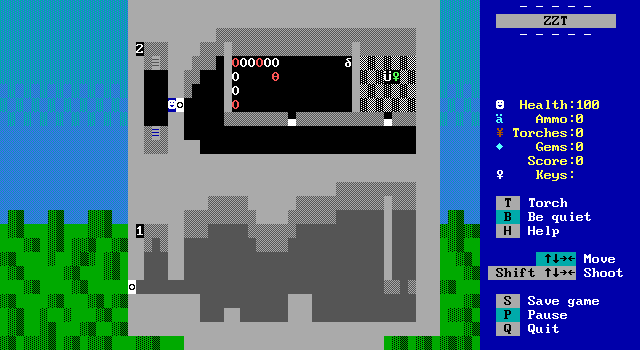
Down on the second floor is a centipede trapped in a small room and another more closed off looking room where there's still another key.
You enter the FAMILIAR HABITAT.
You keep a handful of frightening, witch-y
creatures in here. You don't mind the
CENTIPEDE so much, but you're terrified of
ARACHNE THE SPIDER-QUEEN.
Arachne's an ancient goddess. She took up
residence here a year ago (without asking)
after an angry mob chased her out of her
caves.
You bring her a pig to eat about once a
month. She accepts them begrudgingly,
obviously preferring the villagers she
used to snack on.
You left the BAT GUANO in the centipede
pen. The centipede is aggressive, so
you'll want to AVOID IT.
• • • • • • • • •
This floor reveals some of the personal troubles Mary's had to go through, namely a spider goddess deciding she lives here now. It sounds like it's kind of an awkward relationship.
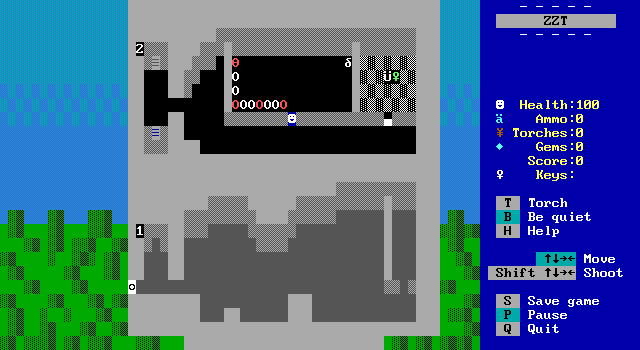
Just like the doppelganger, Mary can't attack her "foe" who is only a foe in the sense that ZZT demands centipedes to be. The centipede is exactly long enough to give Mary a game over which ensures that the centipede must still be alive (even if it's in a few pieces) when Mary has gotten the BAT GUANO she needs.
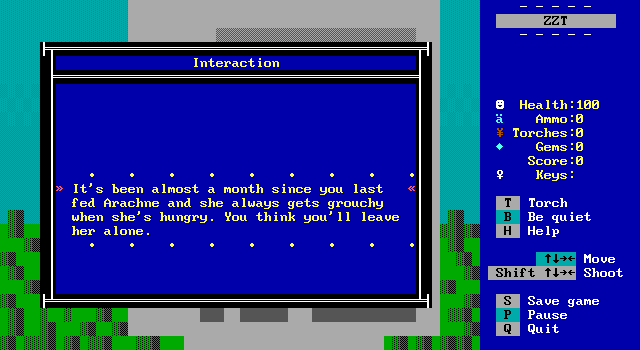
She also (wisely) opts to not interact with Arachne.
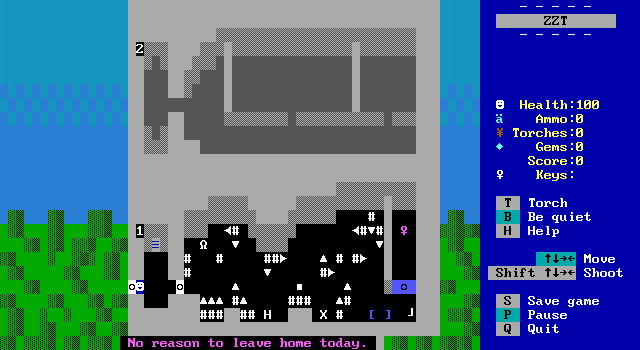
Lastly, the first floor is filled with dangerous looking spikes, as well as the tower exit, but there's no need to go elsewhere.
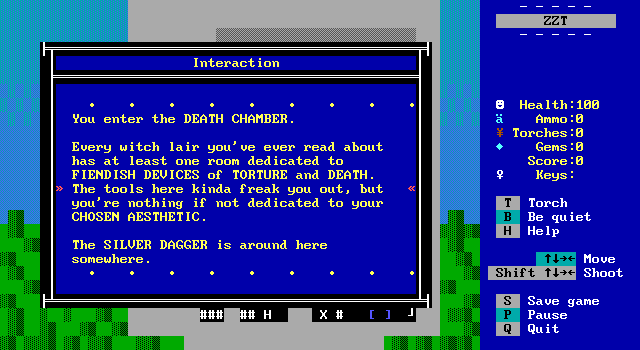
If there was ever going to be a scary part of the game, it's heading to the DEATH CHAMBER. I love how goofy it is. Even Mary only has it because she's expected to have one.

Aside from a lot of spikes, there are still a few things to interact with.

The iron maiden in interesting in that it specifically gives a hint that it will be important later, though I think the way Witch's Tower works, renders the hint kind of unnecessary and a bit out of place with how the game is presented.
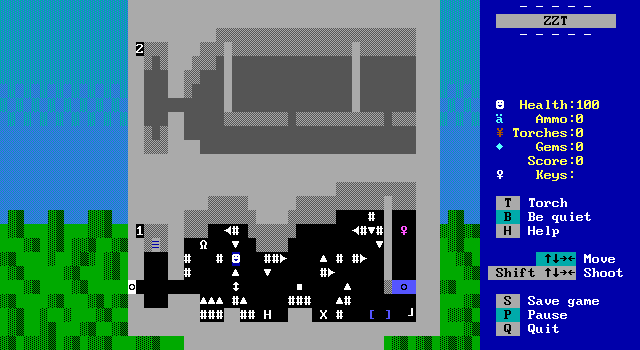
The first few spikes can be avoided by an overly cautious player, but there's a chokepoint here where Mary must let herself stand in front of them. Good news, they're perfectly harmless. Rather than a gory death, all the spikes do is push Mary backwards, sometimes into more spikes that then do the same. It's actually kind of fun to be shoved around by them.
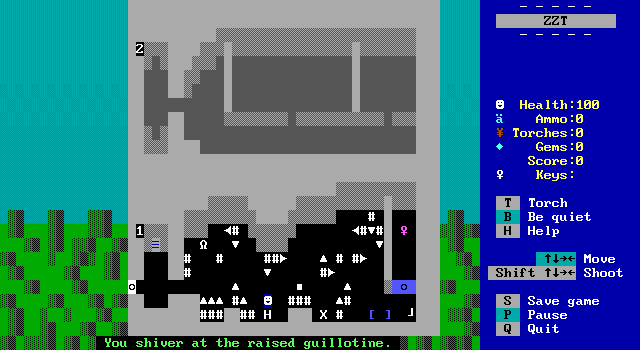
The other macabre instruments include this rather tiny guillotine, and a St. Andrew's cross (that Mary confides she isn't a fan of).
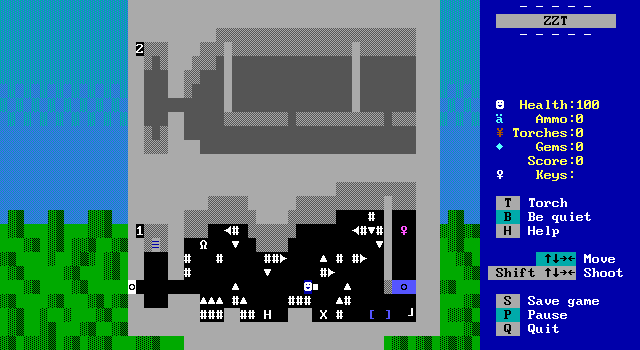
Lastly is a boulder that can be pushed around. Some blue brackets in the corner would appear to be the destination for this, but you're not actually able to get the boulder in place (unless you use the pause button to break things).
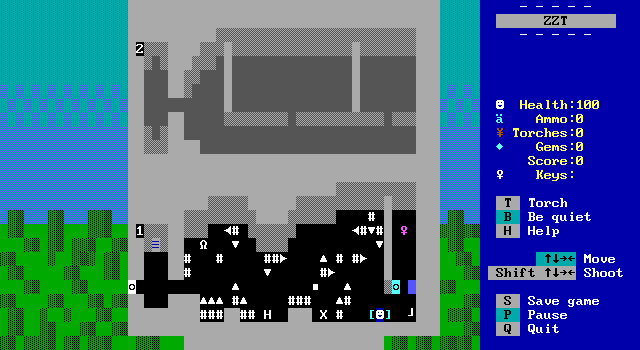
The destination for the boulder is verified as the brackets and door flash colors when the player blocks the tile. Without the boulder being there though, the door closes once more before Mary can get the key. Luckily Mary isn't here for a key.
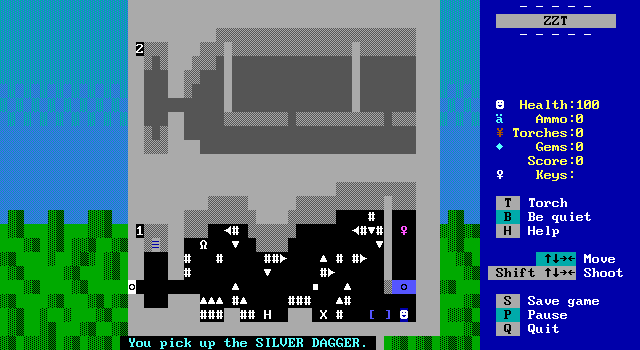
She's here for the dagger in the corner of the room. With the dagger, guano, and tome in her possession, Mary has everything she needs to perform the ritual.

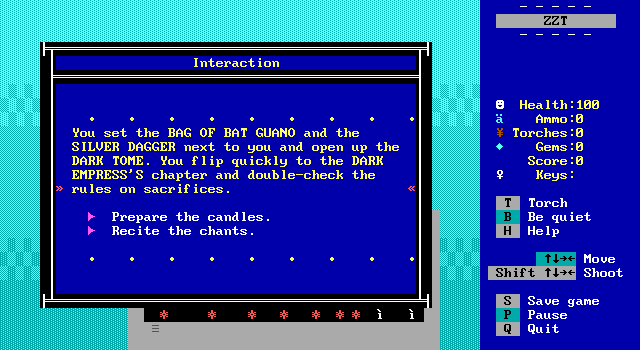
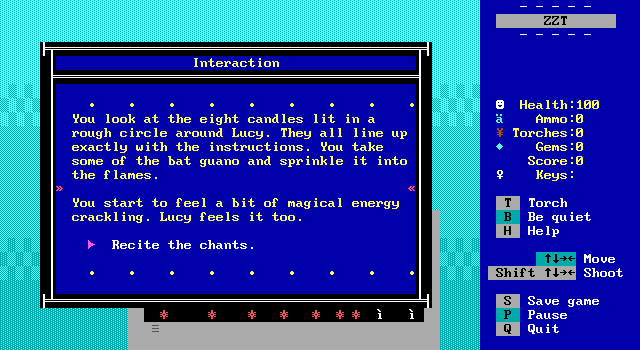
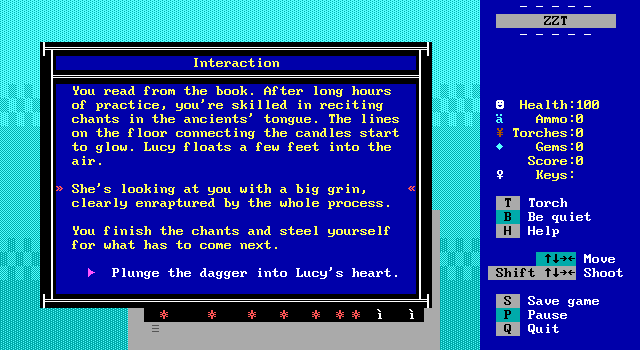
Lucy has been pretty darn excited about this whole thing. She's taking it really well. All that remains is to actually make the sacrifice. For a game that doesn't try to take itself too seriously, this moment is kind of tense.

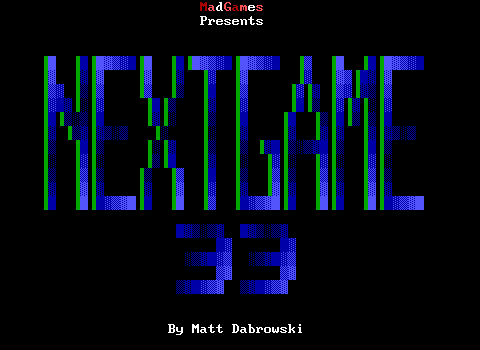

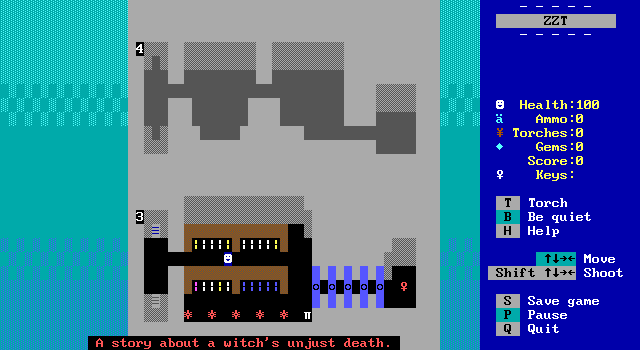
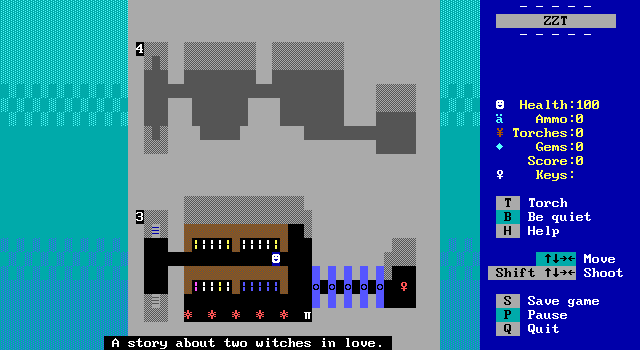
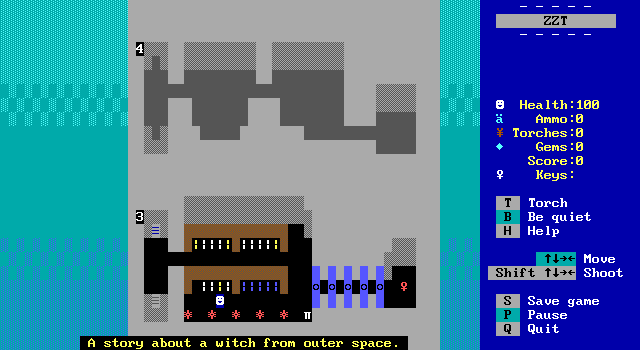
Just look at the title screen! It already looks rather unlike most, making sure to call itself a "game". IT ALSO USES ALL LOWERCASE WHEN THERE WAS LIKE A FIVE YEAR PERIOD WHERE THE ZZT COMMUNITY TYPED IN ALL CAPS LIKE THIS. The shading is simple, using STK colors, and outright checkerboard gradients rather than fading through solid, normal, breakable, and water. It makes the game look like something out of 1995 where STK is a bit of a novelty.